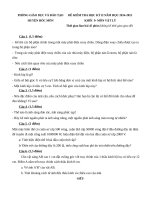052 15 2 CRUD operations using http service detailed tủ tài liệu training
Bạn đang xem bản rút gọn của tài liệu. Xem và tải ngay bản đầy đủ của tài liệu tại đây (608.82 KB, 15 trang )
Deccansoft Software Services
Angular4- CRUD operations using HTTP
As we have learned about $http services in the previous sessions, now we will perform CRUD operations for
employee and department.
Open Visual Studio 2015 go to File New Project Expand Visual C# Web Create ASP.NET Web
Application Check WebApi and MVC
Step1: Creating tables for Employee and Department in SQL Server
Table - Employee
Table - Department
EmpId
Int (PK)
PKDeptId
Int (PK)
EmpName
Varchar(50)
DeptName
Varchar(50)
EmpSalary
Money
FKDeptId
Int (FK)
Step2: Create ADO.NET Entity Data model & Create API’s
Solution Explorer go to Models right click and click Add New Item Visual C# Data ADO.NET
Entity Data Model
Step3: Creating API’s using entity framework
File: ManageDepartmentController.cs
public class ManageDepartmentController : ApiController
{
EmpDeptDBEntities context = new EmpDeptDBEntities();
// GET: api/ManageDepartment
public IEnumerable<Department> Get()
{
return context.Departments;
}
// GET: api/ManageDepartment/5
public Department Get(int id)
{
return context.Departments.Find(id);
}
// POST: api/ManageDepartment
public IEnumerable<Department> AddDepartment([FromBody]Department dept)
{
context.Departments.Add(dept);
context.SaveChanges();
return Get();
}
Deccansoft Software Services
Angular4- CRUD operations using HTTP
// PUT: api/ManageDepartment/5
public IEnumerable<Department> Put([FromBody]Department dept)
{
Department oldDept = context.Departments.Find(dept.DeptId);
context.Entry(oldDept).CurrentValues.SetValues(dept);
context.SaveChanges();
return Get();
}
// DELETE: api/ManageDepartment/5
public IEnumerable<Department> Delete(int id)
{
context.Departments.Remove(Get(id));
context.SaveChanges();
return Get();
}
}
File: ManageEmployeeController.cs
public class ManageEmployeeController : ApiController
{
EmpDeptDBEntities context = new EmpDeptDBEntities();
public List<Employee> Get()
{
List<Employee> lstEmp = context.Employees.ToList();
return lstEmp;
}
public Employee Get(int id)
{
return context.Employees.Find(id);
}
public List<Employee> AddEmployee(Employee emp)
{
context.Employees.Add(emp);
context.SaveChanges();
return Get();
}
public List<Employee> Put([FromBody]Employee emp)
{
Employee oldEmp = Get(emp.EmpId);
Deccansoft Software Services
Angular4- CRUD operations using HTTP
context.Entry(oldEmp).CurrentValues.SetValues(emp);
context.SaveChanges();
return Get();
}
public List<Employee> Delete(int id)
{
context.Employees.Remove(Get(id));
context.SaveChanges();
return Get();
}
}
Step4: Setup the application with quick start files from github, for installation please refer introduction.
Step5: Create directory structure for angular application
Step6: Creating models for Employee and Department
File: app.models.ts
export class Department {
DeptId: number;
DeptName: string;
}
export class Employee {
EmpId: number;
EmpName: string;
EmpSalary: number;
FKDeptId: number;
Department: Department;
constructor() {
}
}
Deccansoft Software Services
Angular4- CRUD operations using HTTP
Step6: Creating root component with selector
File: app.component.ts
import { Component } from '@angular/core';
@Component({
selector: 'my-app',
templateUrl: './template.html',
})
export class AppComponent{ }
File: template.html
<div class="clearfix"> </div>
<div class="container">
Employee Management
<nav>
<button class="btn btn-warning" routerLink="emp">Employees</button>
<button class="btn btn-warning" routerLink="dept">Departments</button>
</nav>
<router-outlet></router-outlet>
</div>
Step7: Creating component,service and template for Department
Here we are using lazyloading for department module
File: app.DeptService.ts
import { Http, Response,RequestOptions,Headers } from '@angular/http';
import { Injectable } from '@angular/core';
import 'rxjs/add/operator/map';
import { Observable } from 'rxjs/observable';
import { Department } from './../app.models';
@Injectable()
export class DeptService {
departments: Department[];
constructor(private http: Http) {
Deccansoft Software Services
Angular4- CRUD operations using HTTP
}
GetDepartments(): Observable<Department[]> {
return this.http.get("/api/ManageDepartment").map((res: Response) => res.json());
}
GetDepartment(deptId: any): Observable<Department> {
const url = `${'/api/ManageDepartment'}/${deptId}`;
return this.http.get(url).map((res: Response) => res.json());
}
AddDepartment(dept: Department): Observable<Department[]>{
let data = JSON.stringify(dept);
let headers: Headers = new Headers({ "content-type": "application/json" });
let options: RequestOptions = new RequestOptions({ headers: headers });
return this.http.post("/api/ManageDepartment/AddDepartment", data, options).map((res: Response) =>
res.json());
}
UpdateDepartment(dept: Department): Observable<Department[]> {
const url = `${'/api/ManageDepartment'}/${dept.DeptId}`;
let data = JSON.stringify(dept);
let headers: Headers = new Headers({ "content-type": "application/json" });
let options: RequestOptions = new RequestOptions({ headers: headers });
return this.http.put(url, data, options).map((res: Response) => res.json());
}
DeleteDepartment(deptId: any): Observable<Department[]> {
debugger;
const url = `${'/api/ManageDepartment'}/${deptId}`;
return this.http.delete(url).map((res: Response) => res.json());
}
}
File: dept.component.ts
import { Component, OnInit, Input } from '@angular/core';
import { DeptService } from './app.DeptService';
import { Department } from './../app.models';
import { CommonModule } from '@angular/common';
@Component({
templateUrl: './DeptTemplate.html',
providers: [DeptService]
Deccansoft Software Services
Angular4- CRUD operations using HTTP
})
export class DeptComponent implements OnInit {
departments: Department[];
department: Department = new Department();
action: string = "Add";
constructor(private deptService: DeptService) { }
ngOnInit() {
this.GetDepartments();
}
Add() {
this.action = "Add";
this.department = new Department();
this.GetDepartments();
}
GetDepartments() {
this.deptService.GetDepartments().subscribe(depts => this.departments = depts);
}
GetDepartment(deptId: any) {
this.deptService.GetDepartment(deptId).subscribe(dept => this.department = dept);
}
AddDepartment() {
this.deptService.AddDepartment(this.department).subscribe(depts => this.departments = depts);
}
EditDepartment(deptId: any) {
this.GetDepartment(deptId);
this.action = "Edit";
}
UpdateDepartment() {
this.deptService.UpdateDepartment(this.department).subscribe(depts => this.departments = depts);
}
DeleteDepartment(deptId: any) {
debugger;
this.deptService.DeleteDepartment(deptId).subscribe(depts => this.departments = depts);
}
}
File: dept.routing.ts
Here we are maintaining separate routing for department to make this module lazy loaded.
Deccansoft Software Services
Angular4- CRUD operations using HTTP
import { ModuleWithProviders } from '@angular/core';
import { Routes, RouterModule } from '@angular/router';
import { DeptComponent } from './dept.component';
const routes: Routes = [
{ path: '', component: DeptComponent }
];
export const routing: ModuleWithProviders = RouterModule.forChild(routes);
File: dept.module.ts
Here we must import CommonModule to use NgModel in lazy loaded module, and no need to import
BrowserModule because we have already imported that in root NgModule.
import { NgModule } from '@angular/core';
import { DeptComponent } from './dept.component';
import { HttpModule } from '@angular/http';
import { FormsModule } from '@angular/forms';
import { routing } from './dept.routing';
import { CommonModule } from '@angular/common';
@NgModule({
imports: [CommonModule, HttpModule, FormsModule, routing],
declarations: [DeptComponent],
bootstrap: [DeptComponent]
})
export class DeptModule { }
File: DeptTemplate.html
<div class="clearfix"> </div>
<div class="container">
<button class="btn btn-primary" data-toggle="modal" data-target="#myModal" (click)="Add()">Add
New</button>
<div class="clearfix"> </div>
<table class="table table-striped table-bordered" style="width:50%">
<thead>
<tr>
<th>Department Name</th>
<th></th>
<th></th>
</tr>
Deccansoft Software Services
Angular4- CRUD operations using HTTP
</thead>
<tbody>
<tr *ngFor="let dept of departments">
<td>{{dept.DeptName}}</td>
<td><button type="button" class="btn btn-info" (click)="EditDepartment(dept.DeptId)" datatoggle="modal" data-target="#myModal">Edit</button> </td>
<td><button type="button" class="btn btn-danger" (click)="GetDepartment(dept.DeptId)" datatoggle="modal" data-target="#deleteModal">Delete</button> </td>
</tr>
</tbody>
</table>
<div id="myModal" class="modal fade" role="dialog">
<div class="modal-dialog">
<div class="modal-content">
<div class="modal-header">
<button type="button" class="close" data-dismiss="modal">×</button>
Add/Edit Department
</div>
<div class="modal-body">
<form name="addEditForm">
<div class="form-group">
<label for="empName">Department Name</label>
[(ngModel)]="department.DeptName" required />
</div>
<div class="form-group">
data-dismiss="modal">Add</button>
*ngIf="action=='Edit'" data-dismiss="modal">Update</button>
<button type="button" class="btn btn-default" data-dismiss="modal">Close</button>
</div>
</form>
</div>
</div>
</div>
</div>
Deccansoft Software Services
Angular4- CRUD operations using HTTP
<div id="deleteModal" class="modal fade" role="dialog">
<div class="modal-dialog">
<div class="modal-content">
<div class="modal-header">
<button type="button" class="close" data-dismiss="modal">×</button>
Are you sure want to delete?
</div>
<div class="modal-body">
Department Name: <b>{{department.DeptName}}</b>
</div>
<div class="modal-footer">
data-dismiss="modal">Yes</button>
<button type="button" class="btn btn-default" data-dismiss="modal">No</button>
</div>
</div>
</div>
</div>
</div>
Step8: Creating component,service and template for Employee
File: app.EmpService.ts
import { Http, Response,RequestOptions,Headers } from '@angular/http';
import { Injectable } from '@angular/core';
import 'rxjs/add/operator/map';
import { Observable } from 'rxjs/observable';
import { Employee } from './../app.models';
@Injectable()
export class EmpService {
employees: Employee[];
constructor(private http: Http) {
}
Deccansoft Software Services
Angular4- CRUD operations using HTTP
GetEmployees(): Observable<Employee[]> {
return this.http.get("/api/ManageEmployee").map((res: Response) => res.json());
}
GetEmployee(empId: any): Observable<Employee> {
const url = `${'/api/ManageEmployee'}/${empId}`;
return this.http.get(url).map((res: Response) => res.json());
}
AddEmployee(emp: Employee): Observable<Employee[]>{
let data = JSON.stringify(emp);
let headers: Headers = new Headers({ "content-type": "application/json" });
let options: RequestOptions = new RequestOptions({ headers: headers });
return this.http.post("/api/ManageEmployee/AddEmployee", data, options).map((res: Response) =>
res.json());
}
UpdateEmployee(emp: Employee): Observable<Employee[]> {
const url = `${'/api/ManageEmployee'}/${emp.EmpId}`;
let data = JSON.stringify(emp);
let headers: Headers = new Headers({ "content-type": "application/json" });
let options: RequestOptions = new RequestOptions({ headers: headers });
return this.http.put(url, data, options).map((res: Response) => res.json());
}
DeleteEmployee(empId: any): Observable<Employee[]> {
const url = `${'/api/ManageEmployee'}/${empId}`;
return this.http.delete(url).map((res: Response) => res.json());
}
}
File: emp.component.ts
import { Component, OnInit, Input } from '@angular/core';
import { EmpService } from './app.EmpService';
import { DeptService } from './../Department/app.DeptService';
import { Employee, Department } from './../app.models';
@Component({
templateUrl: './EmpTemplate.html',
providers: [EmpService, DeptService]
Deccansoft Software Services
Angular4- CRUD operations using HTTP
})
export class EmpComponent implements OnInit {
employees: Employee[];
action: string = "Add";
employee: Employee = new Employee();
departments: Department[];
department: Department = new Department();
constructor(private empService: EmpService, private deptService: DeptService) { }
ngOnInit() {
this.GetEmployees();
}
Add() {
this.action = "Add";
this.employee = new Employee();
this.GetDepartments();
}
GetEmployees() {
this.empService.GetEmployees().subscribe(emps => this.employees = emps);
}
GetDepartments() {
this.deptService.GetDepartments().subscribe(depts => this.departments = depts);
}
GetEmployee(empId: any) {
this.empService.GetEmployee(empId).subscribe(emp => this.employee = emp);
}
AddEmployee() {
this.empService.AddEmployee(this.employee).subscribe(emps => this.employees = emps);
}
EditEmployee(empId: any) {
this.GetEmployee(empId);
this.GetDepartments();
this.action = "Edit";
}
UpdateEmployee() {
this.empService.UpdateEmployee(this.employee).subscribe(emps => this.employees = emps);
}
Deccansoft Software Services
Angular4- CRUD operations using HTTP
DeleteEmployee(empId: any) {
this.empService.DeleteEmployee(empId).subscribe(emps => this.employees = emps);
}
}
File: EmpTemplate.html
<div class="clearfix"> </div>
<div class="container">
<button class="btn btn-primary" data-toggle="modal" data-target="#myModal" (click)="Add()">Add
New</button>
<div class="clearfix"> </div>
<table class="table table-striped table-bordered" style="width:50%">
<thead>
<tr>
<th>Employee name</th>
<th>Employee Salary</th>
<th></th>
<th></th>
</tr>
</thead>
<tbody>
<tr *ngFor="let emp of employees">
<td>{{emp.EmpName}}</td>
<td>{{emp.EmpSalary}}</td>
<td><button type="button" class="btn btn-info" (click)="EditEmployee(emp.EmpId)" datatoggle="modal" data-target="#myModal">Edit</button> </td>
<td><button type="button" class="btn btn-danger" (click)="GetEmployee(emp.EmpId)" datatoggle="modal" data-target="#deleteModal">Delete</button> </td>
</tr>
</tbody>
</table>
<div id="myModal" class="modal fade" role="dialog">
<div class="modal-dialog">
<div class="modal-content">
<div class="modal-header">
<button type="button" class="close" data-dismiss="modal">×</button>
Deccansoft Software Services
Angular4- CRUD operations using HTTP
Add/Edit Employee
</div>
<div class="modal-body">
<form name="addEditForm">
<div class="form-group">
<label for="empName">Employee Name</label>
[(ngModel)]="employee.EmpName" required />
</div>
<div class="form-group">
<label for="empSal">Employee Salary</label>
[(ngModel)]="employee.EmpSalary" required />
</div>
<div class="form-group">
<label for="dept">Department</label>
[(ngModel)]="employee.FKDeptId">
value="{{dept.DeptId}}">{{dept.DeptName}}</option>
</select>
</div>
<div class="form-group">
data-dismiss="modal">Add</button>
data-dismiss="modal">Update</button>
<button type="button" class="btn btn-default" data-dismiss="modal">Close</button>
</div>
</form>
</div>
</div>
</div>
</div>
<div id="deleteModal" class="modal fade" role="dialog">
<div class="modal-dialog">
Deccansoft Software Services
Angular4- CRUD operations using HTTP
<!-- Modal content-->
<div class="modal-content">
<div class="modal-header">
<button type="button" class="close" data-dismiss="modal">×</button>
Are you sure want to delete?
</div>
<div class="modal-body">
Employee Name: <b>{{employee.EmpName}}</b>
</div>
<div class="modal-footer">
<button type="button" class="btn btn-danger" (click)="DeleteEmployee(employee.EmpId)" datadismiss="modal">Yes</button>
<button type="button" class="btn btn-default" data-dismiss="modal">No</button>
</div>
</div>
</div>
</div>
</div>
Step9: Configuring application to use Http service in root NgModule
File: app.module.ts
Here default routing is navigated to EmpComponent in app.routing
import { NgModule } from '@angular/core';
import { BrowserModule } from '@angular/platform-browser';
import { CommonModule } from '@angular/common';
import { AppComponent } from './app.component'; //importing app.component module
import { EmpComponent } from './Employee/emp.component';
import { HttpModule } from '@angular/http';
import { FormsModule } from '@angular/forms';
import { routing } from './app.routing';
@NgModule({
imports: [BrowserModule, HttpModule, FormsModule,routing],
declarations: [AppComponent, EmpComponent],
bootstrap: [AppComponent]
})
export class AppModule { }
Deccansoft Software Services
Angular4- CRUD operations using HTTP
File: app.routing.ts
As we are considering this app.routing as root module we have configured routes in forRoot.
import { ModuleWithProviders } from '@angular/core';
import { Routes, RouterModule } from '@angular/router';
import { EmpComponent } from './Employee/emp.component';
import { DeptComponent } from './Department/dept.component';
const routes: Routes = [
{ path: '', redirectTo: 'emp', pathMatch: 'full' },
{ path: 'emp', component: EmpComponent },
{ path: 'dept', loadChildren: './app/EmpDept/Department/dept.module#DeptModule' }
];
export const routing: ModuleWithProviders = RouterModule.forRoot(routes);
Step10: Now create html file and use your component selector
<script>
System.import('app/EmpDept/main.js').catch(function (err) { console.error(err); });
</script>
<body>
<my-app>Loading...</my-app>
</body>
Output: You can perform all the crud operations.









